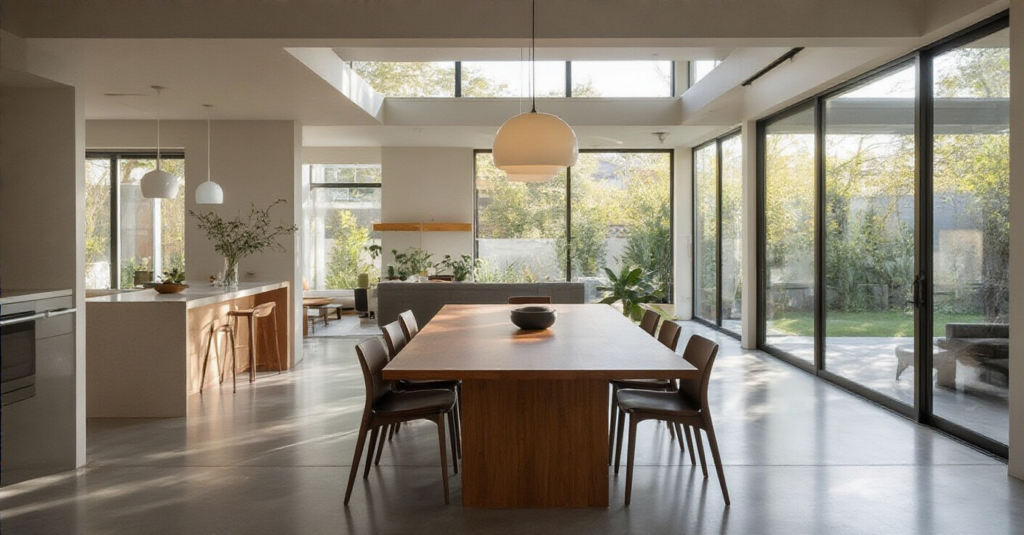You know, people always ask me how to create that “modern Japanese” dining room they see in magazines. They come with lists and budgets, thinking it’s about buying the right objects. And I understand. But they are asking the wrong question. The question is not “What do I buy?” The question is “How do I want to feel in this space?”
A dining room is not a showroom. It is a vessel for connection. It is where you nourish your body and your spirit, where you share time with those you love. So many of these online guides are just noise—lists of trendy items, stats about resale value. That is not the heart of it. The heart is in the intention. So, let’s set aside the shopping list for a moment and talk about what truly matters.
Laying the Modern Foundation: Planning & Principles
Before you choose a single chair, you must understand the ground on which you are building. The foundation of a modern dining room isn’t drywall and floorboards; it’s a philosophy of space, simplicity, and serenity.
1. Embrace Openness: Optimize Layout for Seamless Flow
Everyone talks about “open-concept” living, but they often mistake it for just knocking down walls. This isn’t about creating one giant, loud room. It is about a concept we call ma (間)—the beauty of negative space, the meaningful pause. The space between objects is as important as the objects themselves. It allows energy, light, and people to move without friction. An open layout isn’t a design trend; it’s an invitation to breathe.
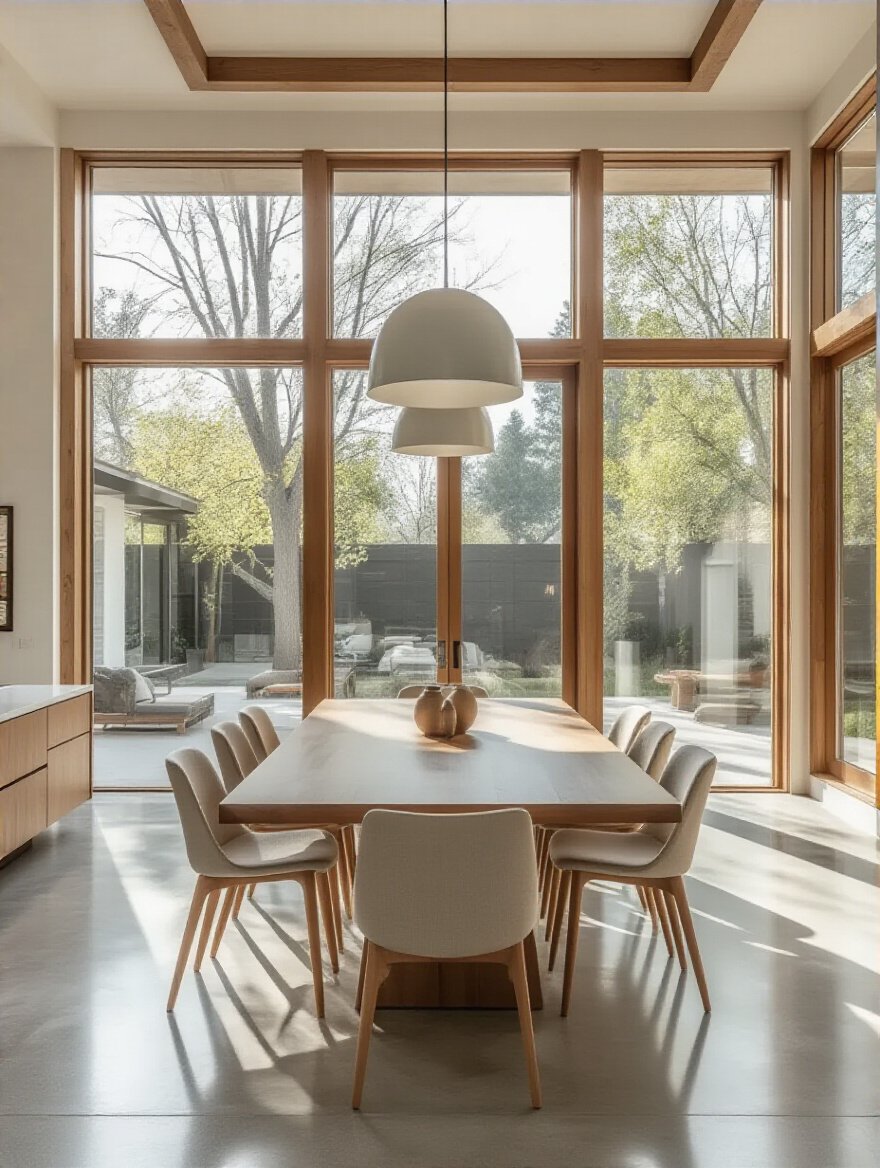
I once worked with a client in a beautiful but tight city apartment. He wanted to cram a formal dining set into a space that couldn’t hold it, creating barriers between the kitchen and the small living area. We spent a whole session not adding furniture, but taking it away. By creating clear pathways and allowing the kitchen island to flow into the dining space, the entire home felt calmer, more expansive. The “emptiness” we created was what finally made it feel full.
So before you plan, simply stand in your space. Observe how the light travels from the window. Notice where you naturally walk. The room itself will tell you where it wants to be open. Your job is simply to listen.
2. Master Minimalism: Declutter for Clean Lines and Serenity
Can we please correct a common misunderstanding? Minimalism is not about cold, empty rooms or getting rid of everything you own. That’s a caricature. True minimalism is about editing your life until only the essential and the beautiful remain. It is about clarity. When you remove the visual noise, the things you have chosen to keep can finally be seen and appreciated for their true worth. A single, beautiful ceramic bowl on a table has more presence than ten mediocre ones.

The real secret is that this process isn’t about subtraction; it’s about amplification. By clearing away the clutter—the mail, the keys, the things that accumulate without thought—you create a serene backdrop for the act of dining. The focus returns to the food, the conversation, the connection. If you want a shortcut, don’t just “declutter.” Find a beautiful, concealed home for everything that doesn’t need to be seen. A sleek sideboard isn’t for showing off your possessions; it’s for graciously hiding them.
This creates a sense of peace, not deprivation. And it gives the remaining elements—a simple vase, a striking Light Fixture—the power to truly sing.
3. Define Your Palette: Choose Cohesive Neutral Tones First
People hear “neutral” and they think “boring.” They think beige, or sterile white. But I want you to think about nature. Think of the color of a wet stone after the rain. The deep gray of a storm cloud. The warmth of sand, the quiet of aged wood. These are not an absence of color. They are the colors of tranquility. A neutral palette is your canvas, and the most important color you will use upon it is light.

These quiet tones create a sense of harmony and allow other things to take center stage: the vibrant green of a plant, the deep red of a wine, the faces of your guests. They don’t shout for attention. A huge mistake people make is choosing a bold wall color first and then trying to force everything else to match. Start with a foundation of calm. The easiest way to do this is to choose a family of neutrals—warm or cool—and then layer them with different textures: a smooth plaster wall, a nubby linen chair, a polished concrete floor.
This layering of textures is the key. It brings depth and warmth to the simplicity, making the space feel rich and considered, not empty.
4. Integrate Natural Light: Maximize Sun Exposure and Views
In Japanese architecture, light is considered a building material. It sculpts space. It marks the passage of time from morning until night. We don’t just want to “get more light in.” We want to welcome it, to guide it, to celebrate it. Too often, people cover their windows with heavy, fussy treatments that choke the very life out of a room. This is a sad thing to see.

The goal is to blur the line between inside and out. If you are renovating, large panes of glass are a gift. If you are not, the strategy is simpler: keep your windows impeccably clean. Use sheer, diaphanous curtains that soften the light without blocking it. And use mirrors—not to check your reflection, but to bounce that precious light into the darker corners of the room. I had a client whose small dining nook faced a brick wall. We placed a large, simple mirror on the opposing wall, and suddenly it reflected the light from the living room window, doubling the sense of brightness and life.
Think of your windows as picture frames. What they frame—the sky, a tree branch, the changing seasons—becomes a living piece of art in your home.
5. Select Durable Materials: Opt for Low-Maintenance, Long-Lasting Surfaces
Here is a place where modern practicality and ancient wisdom meet. The Western obsession with what is new and perfect is exhausting. In Japan, we have a concept called wabi-sabi (侘寂). It is the appreciation of beauty that is imperfect, impermanent, and incomplete. It is the beauty of things that show the marks of time and use. This is the opposite of our disposable culture.
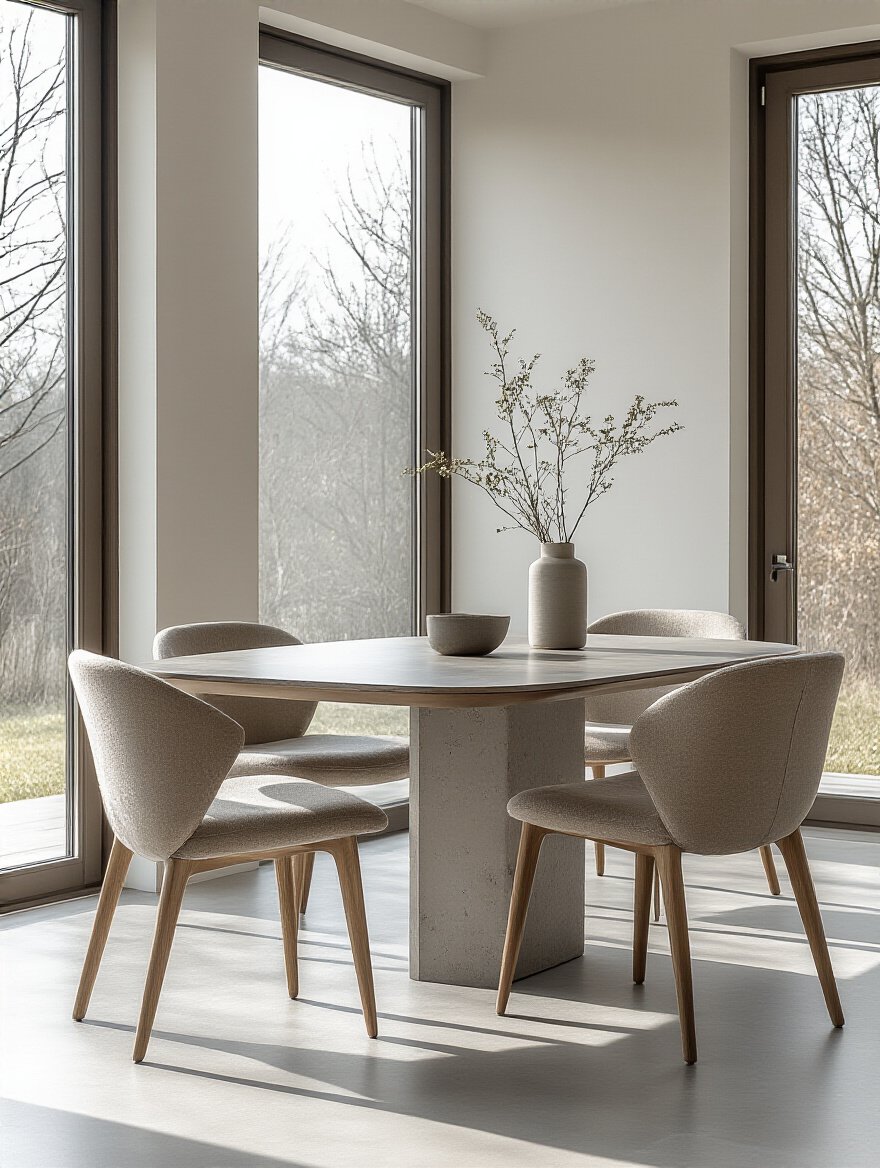
When you choose materials, don’t just think about how they look on day one. Think about how they will look in ten years. A solid wood table that gathers scratches and stains tells the story of the meals and conversations shared around it. A stone floor that patinas with age gains character. This isn’t about choosing materials that are indestructible; it’s about choosing materials that age gracefully. It’s a more sustainable, more soulful way to live. Avoid flimsy veneers and plastics that will chip and yellow.
Invest in honesty: solid wood, real stone, quality metal. These materials have an integrity that not only lasts but deepens over time. It is a profound act of respect for the resources of the earth and for the future of your home.
Core Furnishings: Smart Selections for Style & Comfort
The objects in your room are not just “stuff.” They are the tools for living. The table is the anchor of gathering. The chairs are an embrace for your guests. Choose them not for how they look in a photo, but for how they serve the life you want to live.
6. Choose a Sleek Table: Invest in a Sculptural or Geometric Centerpiece
Your dining table is not just a surface. It is the heart of the room, a piece of functional sculpture around which everything else revolves. So many homes default to a heavy, traditional four-legged table that feels visually clunky and expected. A modern dining room asks for something with more architectural thought. Consider a table with a pedestal base, or a base of interlocking geometric forms.

This does two things. First, it creates visual interest and elegance, a focal point that draws you in. It says, “Something important happens here.” Second, and more practically, it removes the obstacle of corner legs, making it easier for people to slide in and out, especially on a banquette. The form is not just for beauty; it enhances the function. The table becomes a sculpture you can use.
When a client chooses a table like this, made of polished concrete or dark steel, the need for a fussy centerpiece disappears. The table is the main event.
7. Select Ergonomic Seating: Prioritize Comfort with Clean-Lined Chairs
I cannot stress this enough: beauty at the expense of comfort is a design failure. A chair can have the cleanest, most beautiful lines in the world, but if your guests are fidgeting after twenty minutes because their back hurts, the design has not succeeded. The purpose of a dining chair is to hold a person in comfort so they can linger, connect, and enjoy the company.

Modern does not mean uncomfortable. This is a common and damaging myth. Look at the classic chairs of designers like Wegner or Eames. They have beautiful, simple lines, yes, but they were also obsessed with the human form. The curve of the back, the height of the seat—these were studied with immense care. A good dining chair is a quiet hug. It supports you without constricting you.
So, when you choose your chairs, please, sit in them. Sit for a while. Imagine a long, wonderful meal. Do you feel supported? Do you feel at ease? That is your answer. Comfort is a form of hospitality.
8. Incorporate a Statement Credenza: Add Stylish, Functional Storage
A modern dining room requires tranquility, and tranquility is impossible amidst clutter. The credenza, or sideboard, is your most elegant ally in this pursuit. It’s a long, low piece that provides substantial storage while maintaining a clean, horizontal line that is calming to the eye. It is the home for all the things you need for dining but do not need to see: extra placemats, serving dishes, candles, vases.
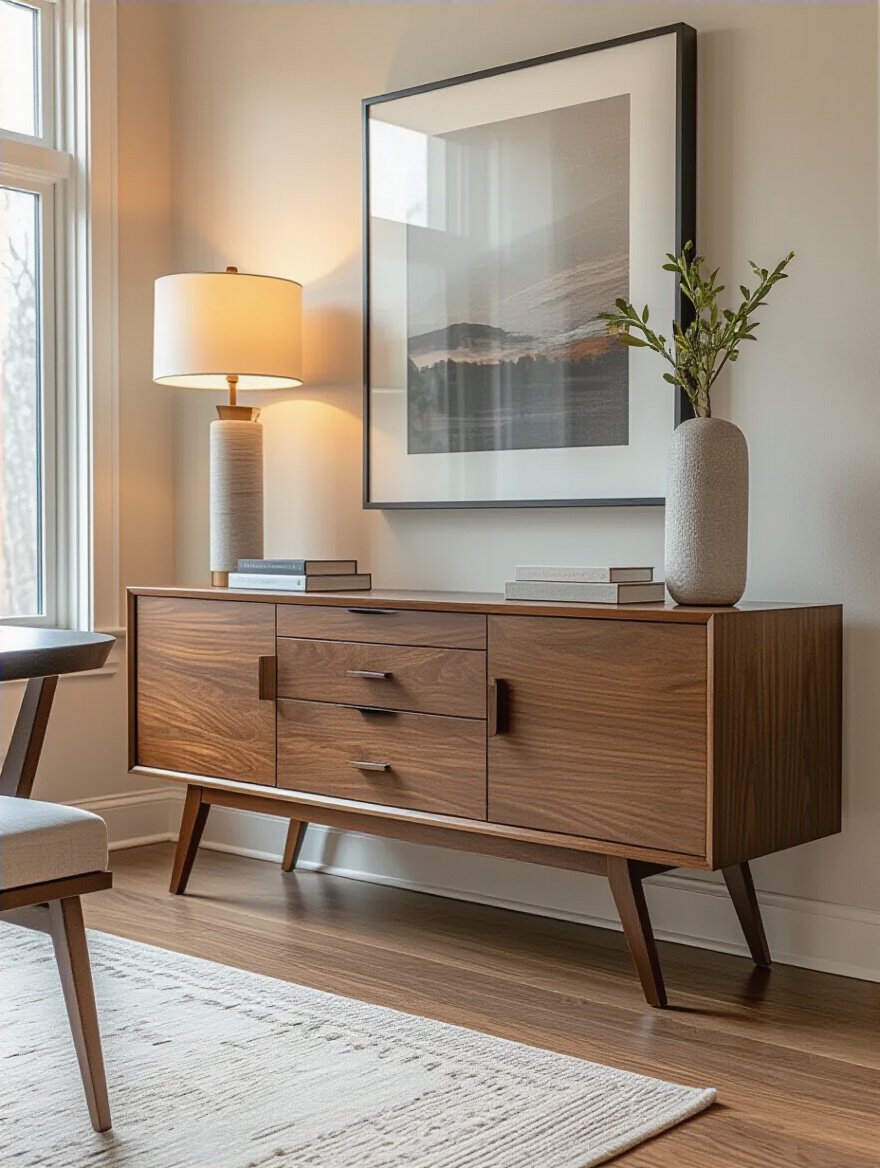
Its function is to create serenity through organization. I advise clients to choose one with simple hardware—or no hardware at all, with push-to-open doors. This keeps the visual plane clean. The top surface should not become a new shelf for clutter. Think of it as an altar. It is the place for one single, beautiful object: a piece of art, a lamp, a special bowl. Or, it can be left completely empty, allowing the beauty of its material—the grain of the wood, the sheen of the lacquer—to be the statement.
The credenza’s purpose is one of quiet service. It hides the noise so you can enjoy the music.
9. Consider Banquette Seating: Maximize Space and Comfort Cleverly
There is a wonderful intimacy to banquette seating. Instead of individual chairs, a shared bench brings people closer together, creating a cozy, communal feeling reminiscent of a favorite café or a family booth. In smaller spaces, it is a brilliant solution for maximizing seating. By pushing the table against the wall-hugging banquette, you can save a significant amount of floor space that would otherwise be needed for pulling chairs in and out.

A friend of mine transformed his tiny apartment dining area with this. He had a small table for two, but he loved to host. We designed a simple, clean-lined banquette along one wall with built-in storage underneath. Paired with a pedestal table and two chairs on the opposite side, he could suddenly seat six people comfortably in a space that previously felt cramped with four. It completely changed how he could use his home.
The trick is to upholster it in a durable, high-performance fabric. This makes it comfortable, inviting, and practical for the inevitable spills of a life well-lived.
10. Add an Expandable Table: Ensure Versatility for Entertaining Needs
A home should adapt to your life, not the other way around. Most days, your dining needs might be small—just you, or your immediate family. But on other days, you may want to welcome a crowd of friends and loved ones. An expandable table is an elegant tool for this very duality. It honors both the quiet, everyday meal and the large, joyous celebration.
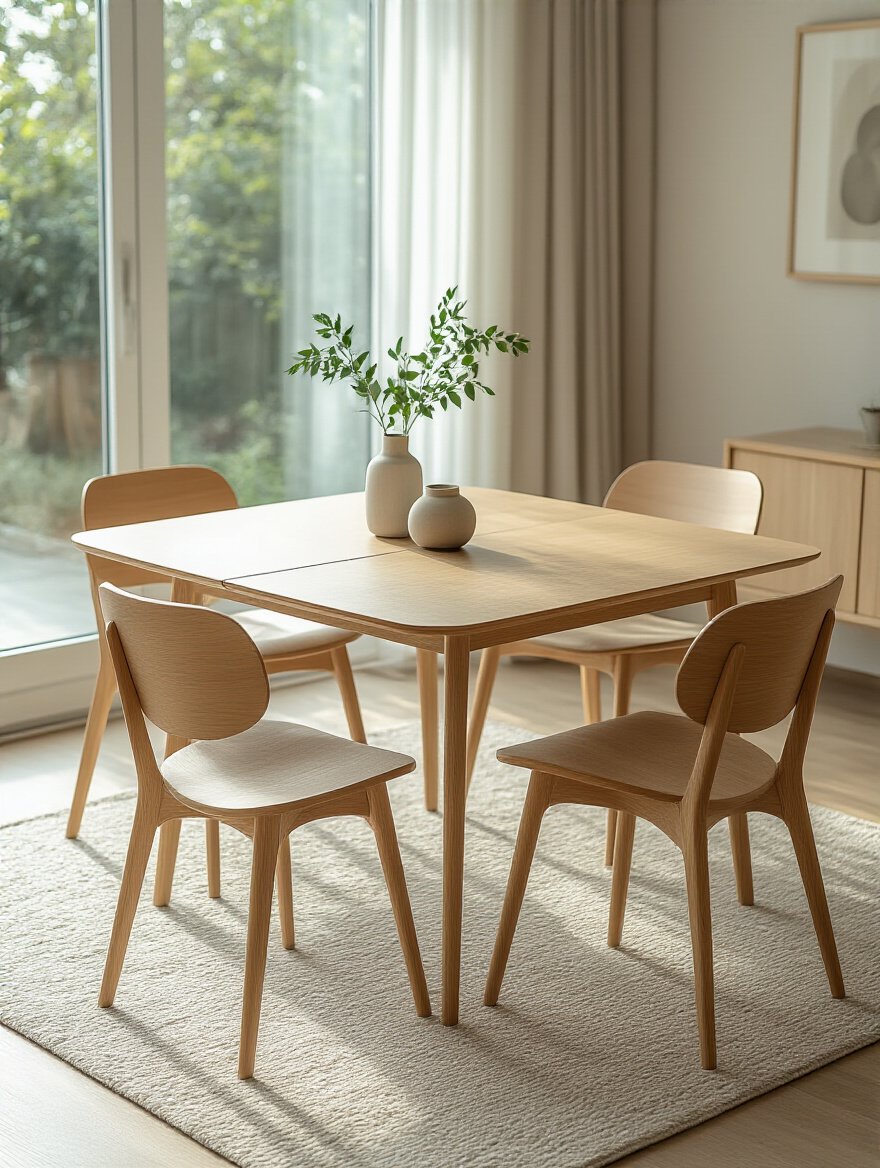
I used to think expandable tables were clunky and awkward, with leaves you had to store in a closet. The mechanisms today are truly things of beauty. Many modern tables have a “butterfly leaf” that folds and tucks away inside the table itself. The transformation is seamless, a quiet act of mechanical poetry. It allows your room to be a peaceful space for two on Tuesday, and a boisterous hall for ten on Saturday, without compromise.
This is the essence of smart, modern design: flexibility that doesn’t sacrifice form. It allows your home to be a quiet retreat and a generous host.
Elevating the Aesthetic: Lighting & Decorative Touches
Now we move from the body of the room to its soul. These are the elements that create mood, personality, and a sensory experience. This is where you move beyond function and begin to compose a feeling.
11. Layer Your Lighting: Combine Task, Ambient, and Accent Fixtures
A single, harsh light in the center of the ceiling is an act of violence against ambiance. It flattens everything, casts unflattering shadows, and kills any hope of intimacy. Please, do not do this. A well-lit room is like a beautiful painting; it has layers of light and shadow. You need three kinds of light, all on separate controls.
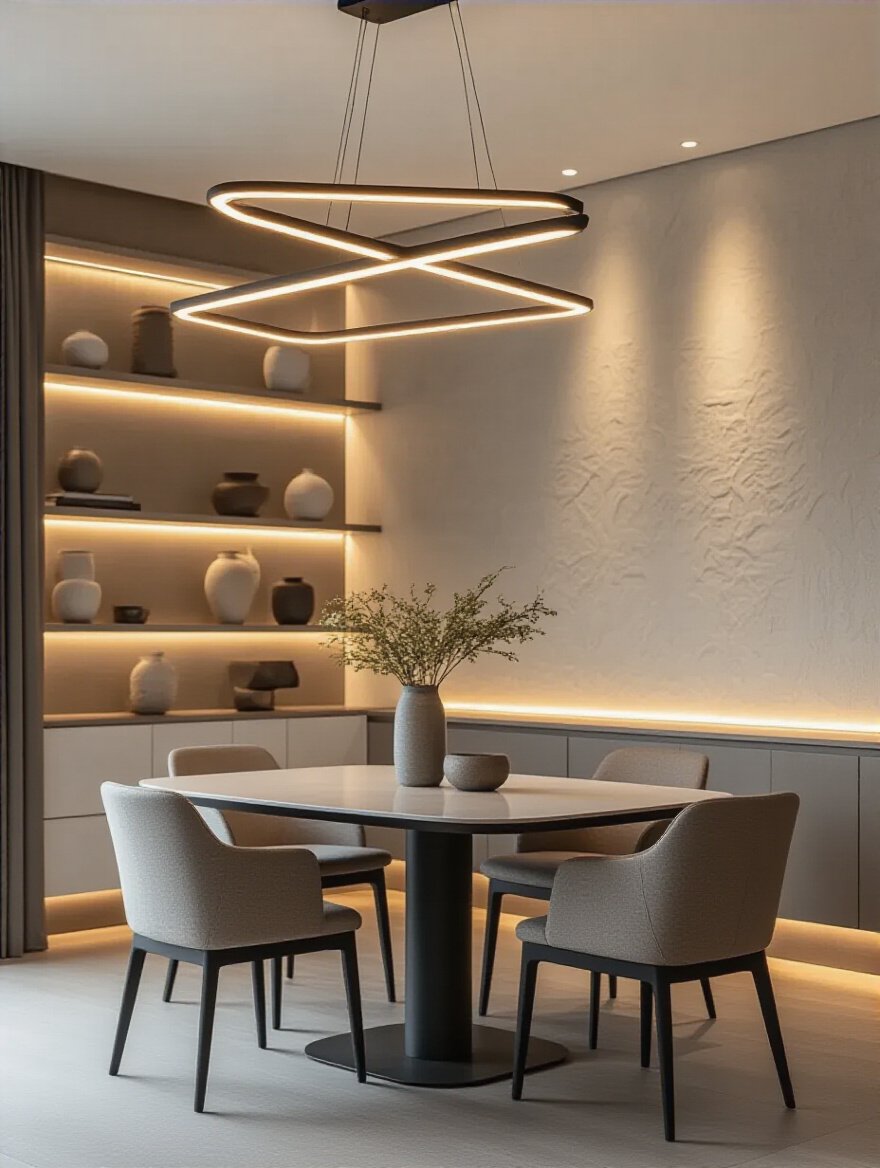
First, Ambient light for general illumination—often from recessed lights, or an uplight that bounces a soft glow off the ceiling. Second, Task light, which is the most important: a beautiful pendant or chandelier directly over your table, illuminating the food and the faces of your companions. This creates a pool of intimacy, a circle of focus. Third, Accent light to highlight something beautiful, like a piece of art or a textured wall.
“A well-designed lighting scheme is not just about illuminating a space; it’s about crafting an emotional response.” – Sarah Wilkie
This layering gives you complete control over the feeling of the room, allowing it to be bright and functional for a family project, or warm and magical for a special dinner.
12. Install Dimmable Switches: Adjust Ambiance for Every Occasion
If you only take one piece of advice from this entire conversation, let it be this: put every single light in your dining room on a dimmer. It is the single most powerful and cost-effective tool you have for controlling the mood of a space. It is non-negotiable. Without dimmers, your beautifully layered lighting scheme is useless, locked into one level of brightness.
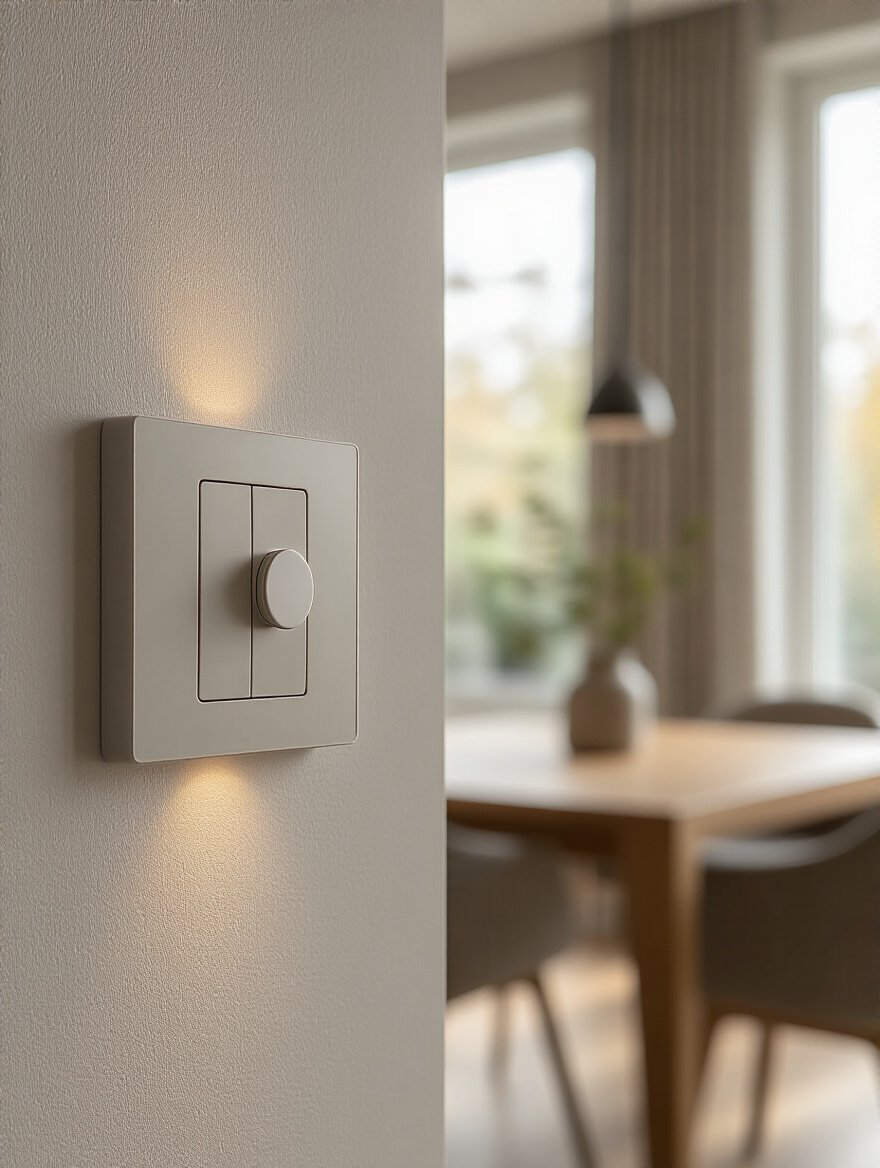
With dimmers, you become the conductor of your room’s atmosphere. You can dial the light down to a soft, candle-like glow for an intimate dinner, or bring it up to a clear, bright level for a game night. I’ve seen clients spend thousands on furniture and forget this simple hundred-dollar upgrade, and their room always feels like it’s missing something. It is missing the ability to whisper.
This small electrical change is the switch between a room that is merely lit and a room that is alive.
13. Curate Abstract Art: Infuse Personality with Bold Visuals
A piece of figurative art—a landscape, a portrait—tells you what to see. A piece of abstract art invites you to feel. It is a field of color, a gesture, a texture. It doesn’t provide answers; it creates a space for your own thoughts and emotions to arise. In a dining room, where conversation and connection are the goals, this can be a powerful catalyst.

Do not be intimidated by abstract art. You do not need an art history degree to choose it. The only question that matters is, “How does this make me feel?” Choose something that resonates with you on an emotional level. Let it be the one burst of bold color in a neutral room, or a quiet, textural piece that invites closer inspection.
Position it so it becomes a focal point, but not an overpowering one. And please, light it properly with a dedicated accent light. When you honor a piece of art with good lighting, you elevate it, and it elevates the entire room in return.
14. Introduce Natural Elements: Soften Edges with Plants and Wood Accents
A room devoid of nature feels sterile and lifeless. The modern aesthetic, with its clean lines and hard surfaces, especially needs the softness and vitality that only nature can provide. This is about shizen (自然), our innate connection to the natural world. A room is not truly complete until it has something living in it.
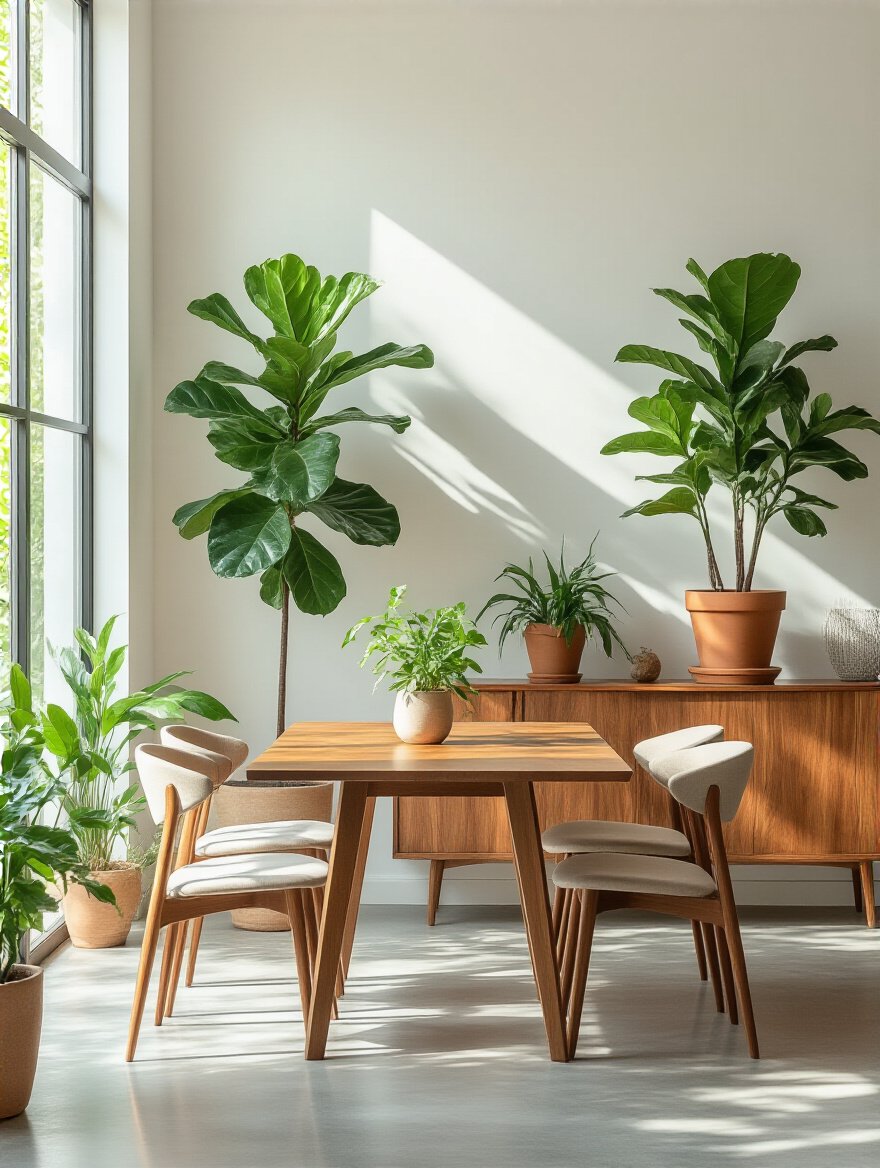
This doesn’t mean you need to turn your dining room into a jungle. A single, beautiful plant with a strong sculptural form—like a Fiddle Leaf Fig or a Strelitzia—can be enough. It brings a living, breathing presence to the space. Also, incorporate wood. If your table is metal or stone, consider wooden chairs. Place a simple, hand-carved wooden bowl on the credenza. These organic touches are essential for balancing the coolness of modern materials.
The imperfect, organic lines of a plant branch or the grain of a piece of wood are the perfect counterpoint to the clean geometry of the room. They are what make it feel human.
15. Mix Textures Deliberately: Balance Smooth and Rough Materials Effectively
Close your eyes and imagine running your hand over the surfaces in your dining room. A truly beautiful space engages more than just the eye. The deliberate mixing of textures is what gives a minimalist space its soul and prevents it from feeling flat or cold. It’s the silent conversation between different materials.

Think in contrasts. If you have a sleek, polished concrete floor, place a soft, hand-knotted wool rug beneath the table. If your dining table has a smooth, lacquered top, pair it with chairs upholstered in a rough, nubby linen or a rich velvet. The smooth reflects light; the rough absorbs it. The interplay between them is what creates depth and richness.
I remember a project where the room felt almost too perfect, too sleek. We introduced a single element—a set of hand-thrown ceramic plates with a slightly irregular, matte glaze. That tiny bit of tactile roughness was all it took to make the entire space feel grounded and inviting.
Finishing Touches & Functional Enhancements
The final layers are subtle, but they separate a good room from a great one. They address the senses that are often forgotten—hearing, ease of use—and ensure the space functions as beautifully as it looks.
16. Optimize Acoustics: Employ Soft Furnishings for Noise Reduction
Have you ever been in a beautiful restaurant where you had to shout to be heard? The hard surfaces—glass, tile, stone—bounce sound around, creating a cacophony. The same can happen in a modern dining room. Sound is an often-ignored element of design, but it has a profound impact on comfort. A room that is acoustically calm is a room where conversation can flourish.
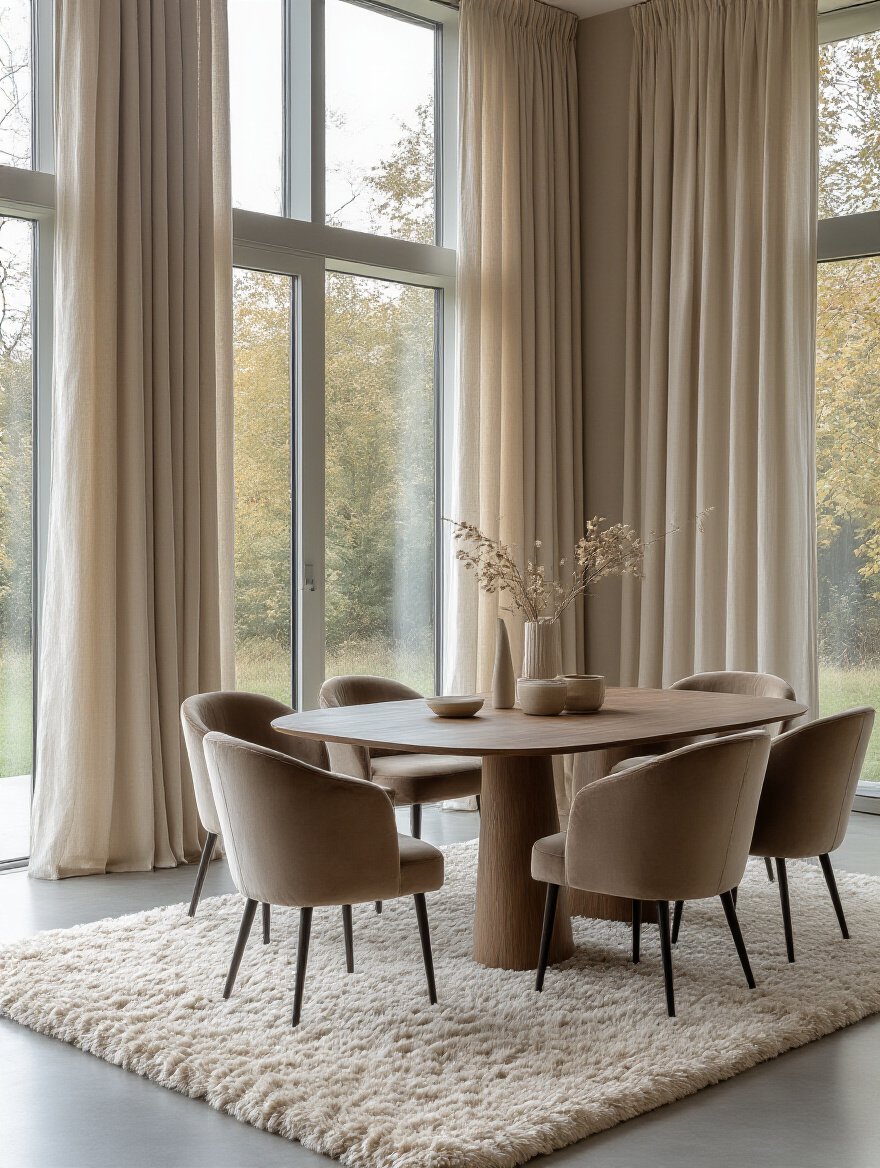
This is a simple problem to solve. Soft surfaces absorb sound. The easiest solutions are an area rug under the table, upholstered dining chairs, and curtains over the windows. Even a textile wall hanging can make a significant difference. You are essentially adding soft, absorbent layers to buffer the sound waves.
The goal is to create a space with a pleasant hum, not a sharp echo. It’s a sign of respect for your guests and their conversations, allowing them to speak in relaxed tones instead of competing with the room itself.
17. Incorporate Smart Technology: Enhance Convenience and Control
Technology should serve you, not dominate you. When integrated thoughtfully, smart technology can enhance the serenity of a room by making it effortless to control. The goal is for the technology to disappear, to work so seamlessly that it feels like magic. There is nothing modern about fumbling with ten different switches or remote controls.
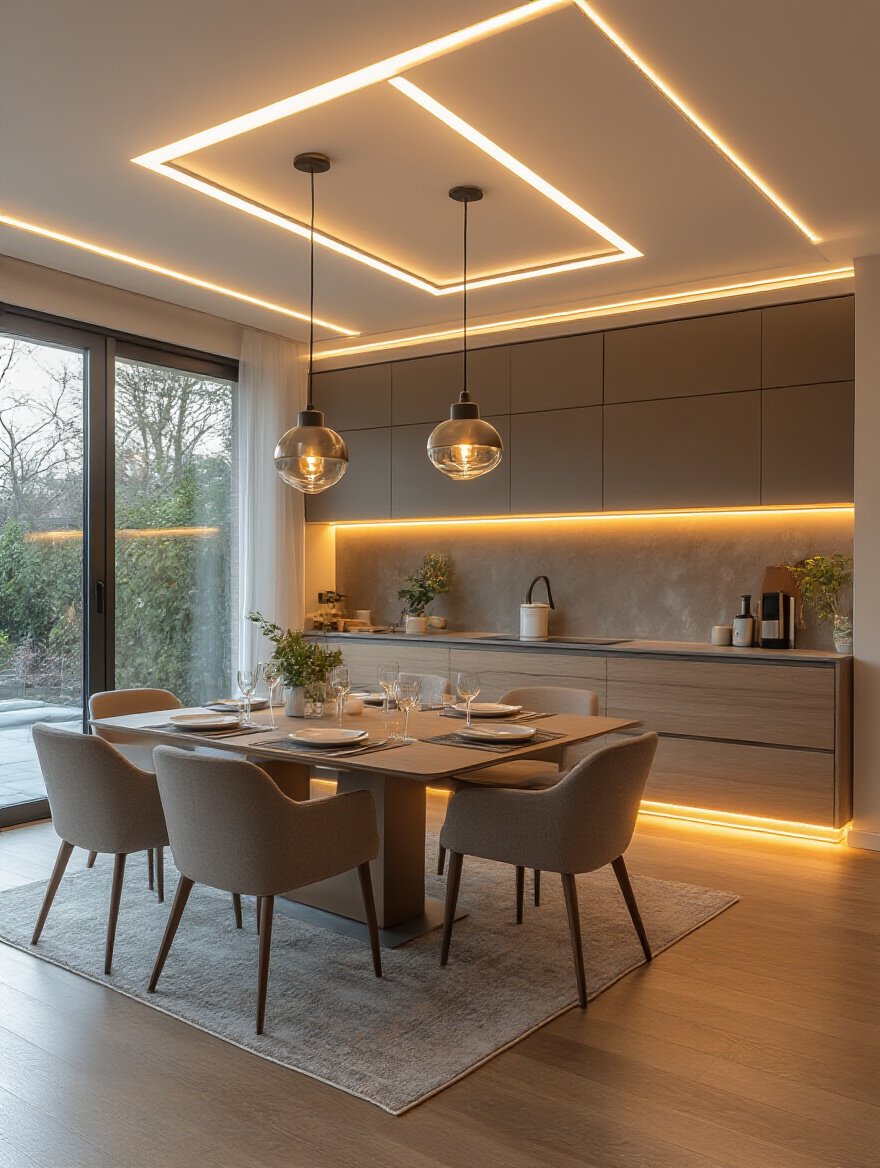
The most impactful use in a dining room is smart lighting. Imagine saying, “Dinner time,” and having the lights automatically dim to your favorite warm, intimate setting while a soft playlist begins to play from hidden speakers. This isn’t a gimmick; it’s a modern ritual. It helps you transition from the chaos of the day into a more present, mindful state for your meal.
Choose systems that are simple and can be integrated. Start with lighting and perhaps audio. The key is to use technology to reduce friction and create atmosphere, not to add more screens and distractions to your life.
18. Choose Dynamic Centerpieces: Create Evolving Focal Points Seasonally
A static centerpiece—a permanent arrangement of silk flowers or a bowl of decorative balls—is a dead thing. It gathers dust and the eye learns to ignore it. A dining room is a living space, and its centerpiece should reflect that. This is the perfect place to practice the Japanese art of ikebana, or simply to bring a piece of the outside world in.
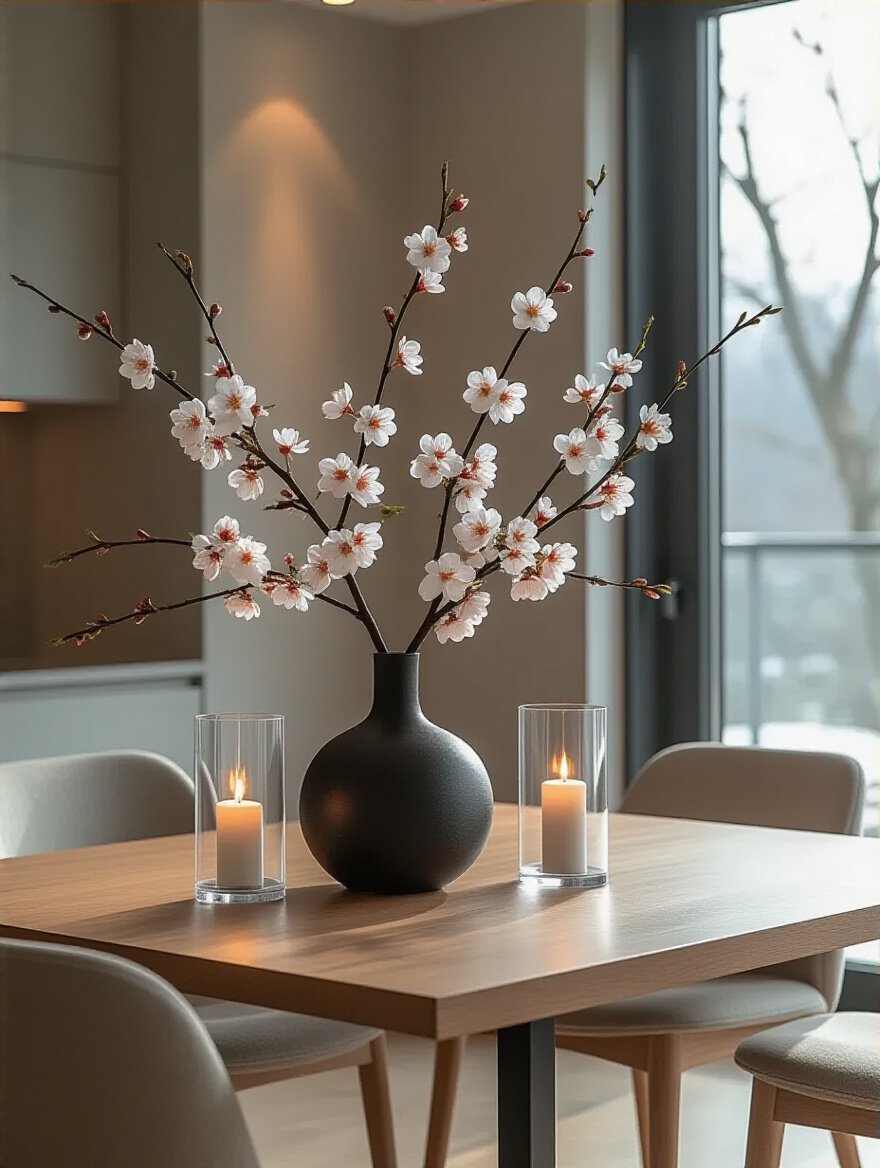
Let your centerpiece change with the seasons. In spring, a single branch of cherry blossoms. In summer, a bowl of fresh lemons. In autumn, a collection of beautiful leaves or shapely gourds. In winter, a simple spray of evergreen boughs. This small act connects your home to the rhythm of the year and keeps the space feeling fresh and alive.
The secret is to keep it simple and low. The centerpiece should never be so tall that it obstructs the view of the person across from you. Its purpose is to add a touch of life, not to create a barrier.
19. Select Contemporary Tableware: Elevate Every Dining Experience
The things you touch every day should be a source of quiet pleasure. Your tableware—plates, bowls, glasses, flatware—is not just a functional tool; it is the final layer of your dining room’s design. It’s the part your guests will interact with most intimately. Choosing it with care elevates the entire experience, from a simple bowl of soup to a celebratory feast.

You don’t need formal china that sits in a cabinet. Instead, invest in a core set of high-quality, contemporary tableware that feels good in your hands. Look for simple shapes, honest materials like stoneware or porcelain, and a cohesive palette that complements your room. I love pieces from artisans, where you can feel the slight imperfections that remind you they were made by a human hand.
Layering can be beautiful here, too. A matte ceramic plate on a simple linen placemat with well-balanced, weighty flatware. This attention to tactile detail turns eating into a more mindful, sensory experience.
20. Plan for Future-Proofing: Ensure Adaptability for Changing Needs
A home is not a museum. It is a living, breathing entity that must evolve as your life changes. Children grow, you may work from home, your style might shift. A truly well-designed space is not a finished product; it’s a flexible framework that can adapt.

This means choosing foundational pieces that are timeless, not trendy. An extendable table, as we discussed. A neutral palette that can be easily updated with new pillows or art. Modular storage that can be reconfigured. By investing in quality, flexible basics, you give yourself the freedom to evolve without needing a complete overhaul every few years. This is more sustainable, more economical, and far more peaceful.
Think of your dining room as a stage. The stage itself is built to last. The actors, the props, and the lighting can change with every new act of your life.
Conclusion
So, you see, creating a modern dining room is a far more profound act than simply following a list of tips. It is a meditation on space, light, and intention. It’s about stripping away the non-essential to reveal a quiet beauty. It is about balancing the clean lines of modernity with the warmth of natural textures, and the precision of design with the comfort of a welcoming embrace.
Forget about creating a “perfect” room to impress others. Instead, focus on creating a harmonious space that nourishes you and the people you love. A space that invites you to linger, to connect, to be present. That is the true purpose of a dining room. And when you design from that place of intention, the result will be more beautiful and more lasting than any trend. It will be a reflection of you.
